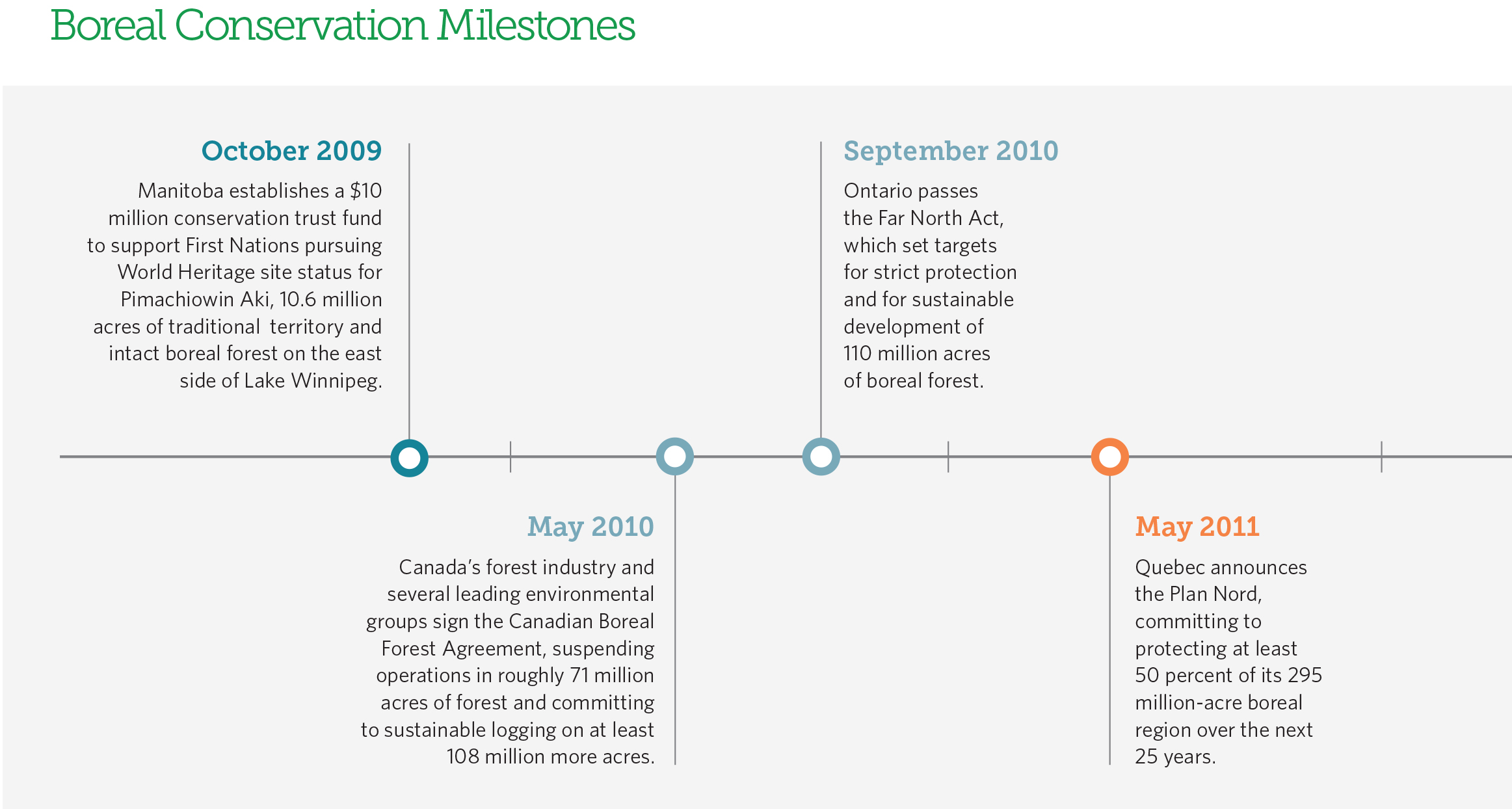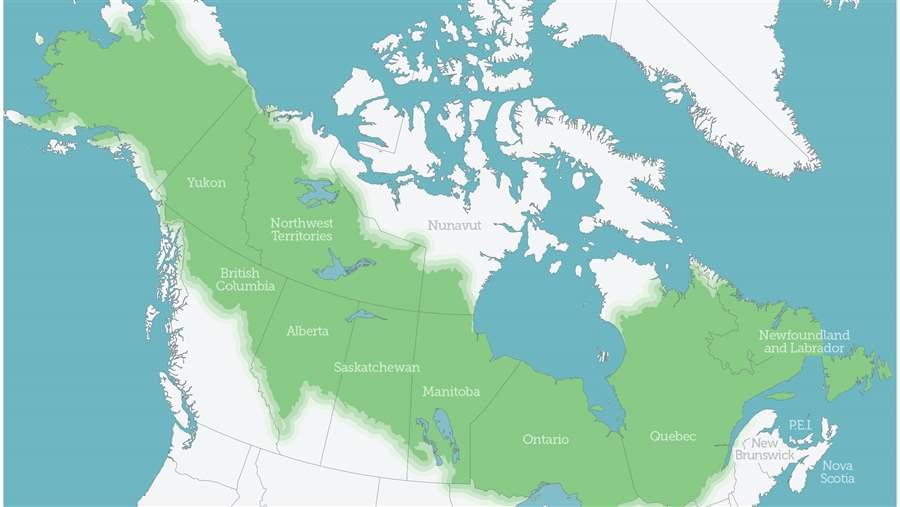Sustaining Canada's Boreal Forest
A conservation success story from the nation’s North
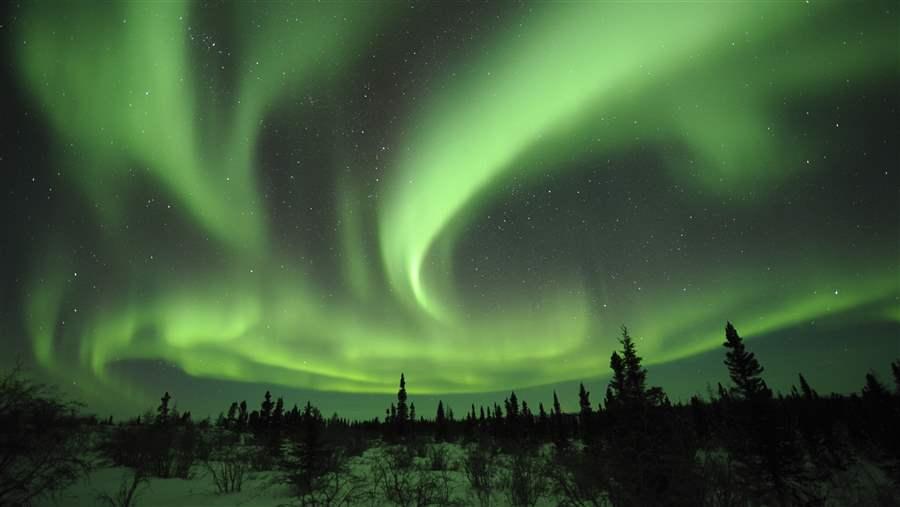 Getty Images
Getty ImagesOverview
If wild places are rich in solitude, then Canada’s vast boreal forest possesses wealth in abundance.
This region, stretching from Yukon to Newfoundland and Labrador, is that increasingly rare place where stars illuminate a night sky unpolluted by ambient light, and where the loudest sounds are natural ones: the call of a lonely loon over a glass-clear lake or the wind whispering through snowy stands of spruce and tamarack. In the dark of winter, the aurora borealis splashes a brilliant palette of color on a canvas that spans the horizon.
For its natural aesthetics alone, Canada’s boreal region is a wilderness that deserves protection. But the broader environmental value that this forest landscape adds to the planet makes its conservation a global imperative.
The boreal’s natural wealth sustains hundreds of Canada’s Indigenous communities, whose inhabitants have lived in harmony with the forest for millennia. It also supports thousands of jobs and contributes billions of dollars to the Canadian economy.
Protecting the long-term integrity of the boreal forest is critical to the sustainability and well-being of its communities, as well as the economic and ecological goods and services it provides.
The challenge—and opportunity—lies in striking a balance between development and protection.
Today, the boreal forest in Canada is one of the world’s most threatened ecosystems because of mounting demands for minerals, energy, timber, and water resources. Since 1975, more than 75 million acres have been logged.
Despite these threats, however, governments, Indigenous peoples, conservationists, and businesses in Canada are taking important—even visionary—steps to protect this global treasure.
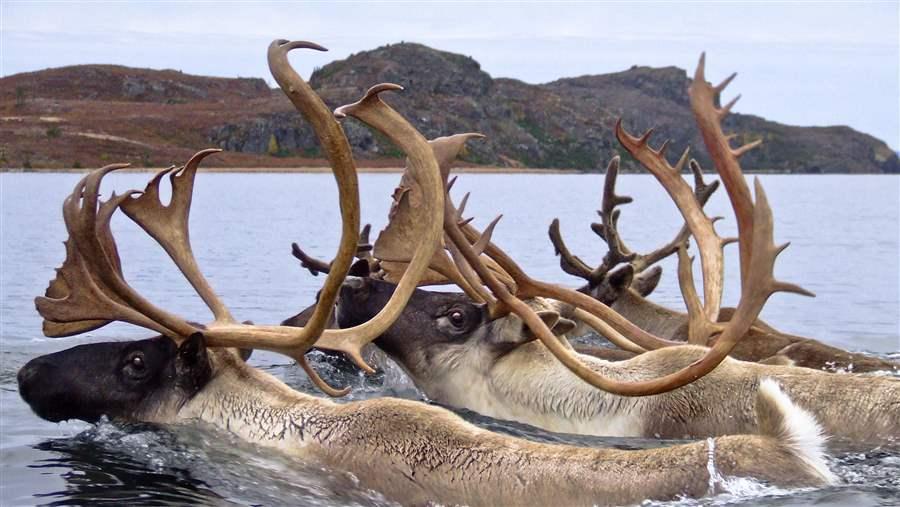 Valerie Courtois
Valerie CourtoisCaribou swimming across Kamestastin Lake in Labrador.
Why protecting Canada’s boreal region matters
- Bigger is better. At roughly 1.2 billion acres, Canada’s boreal is the world’s largest remaining old-growth forest and one of the last continental-scale ecosystems still largely undeveloped. It represents 25 percent of the world’s remaining intact forest, even more than the Amazon rain forest. Science shows that establishing large, interconnected protected areas in a landscape-scale environment is vital to maintaining a full spectrum of wildlife.
- Water, water, everywhere. Canada’s boreal region harbors the planet’s largest expanse of wetlands, lakes, and rivers. It holds the largest unfrozen source of freshwater on the globe and has 200 million acres of surface water. In the Northwest Territories, Great Bear Lake is considered the world’s largest unpolluted lake, and Great Slave Lake is North America’s deepest.
- The “Fort Knox of Carbon.” The rich soils and permafrost of Canada’s boreal forest store twice as much carbon per acre as tropical rain forests and are critical for mitigating the effects of climate change. In all, Canada’s boreal locks in a minimum of 208 billion metric tons of carbon.
- Bountiful biodiversity. Canada’s boreal forest teems with wildlife rare or endangered elsewhere, including millions of caribou. Species that have lost much of their original range in North America—including grizzly bears, wolverines, lynxes, and wolves—sustain themselves in the region.
- North America’s bird nursery. Canada’s forest provides critical nesting grounds for almost half of all North American migratory songbirds and waterfowl. Each year, 1 billion to 3 billion birds migrate north to nest in Canada’s boreal forest. Between 3 billion and 5 billion return south each fall following a successful breeding season.
- Last stand for forests. As industrial civilization has expanded, the world has lost almost 80 percent of its original old-growth forests. Just three places account for much of what remains: the Amazon rain forest, the Russian taiga, and the North American boreal forest.
- A shared Canada-U.S. asset. North America’s boreal region knows no national boundaries. Including Alaska’s remaining boreal, this ecosystem covers more than 1.5 billion acres.
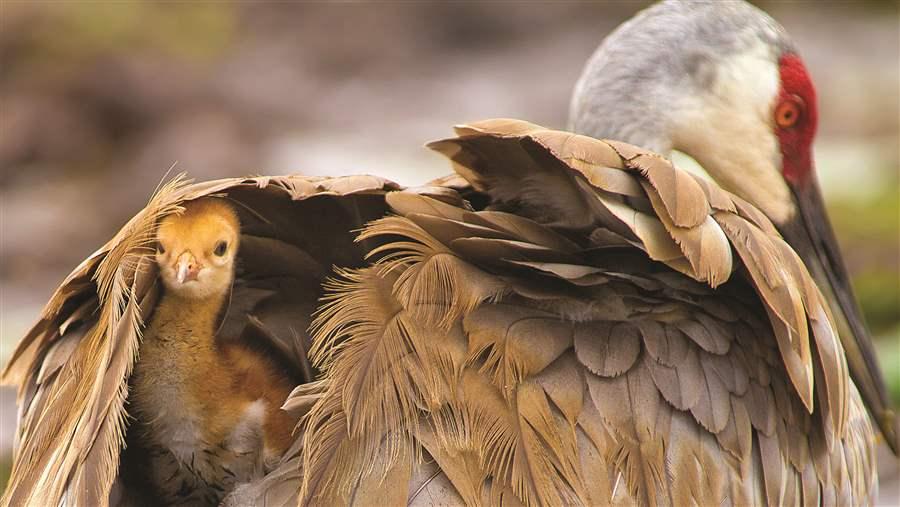 Getty Images
Getty ImagesA sandhill crane chick peeks out from its shelter of feathers. About a third of the species’ North American population breeds in the boreal forest..
Partners in protection
In 2000, The Pew Charitable Trusts launched an international campaign seeking large-scale protection of Canada’s boreal forest. The coalition includes Ducks Unlimited Inc., Ducks Unlimited Canada, the William and Flora Hewlett Foundation, the Gordon and Betty Moore Foundation, the Boreal Songbird Initiative, the Canadian Parks and Wilderness Society, the Indigenous Leadership Initiative, The Nature Conservancy, and the Prince Albert II Foundation.
More than 1,500 scientists from around the world, dozens of major companies, Canadian First Nations (Indigenous governments recognized by Canada), and Canadian and international environmental organizations now work with us to protect Canada’s boreal forest.
The Canadian Boreal Conservation Framework is at the heart of the effort to protect this vast region. The vision document, created in 2003, calls for conservation and sustainable development encompassing the entire 1.2 billion-acre forest. It was developed jointly by industry, conservationists, Indigenous leaders, and conservation scientists. Under the framework, at least 50 percent of the boreal forest would be reserved in large interconnected protected areas for nature. Conservation science shows that target must be met for the boreal to maintain the full complement of species, communities, and ecosystem services. For the remainder, the framework offers a path for responsible, sustainable economic development, using world-leading resource management practices.
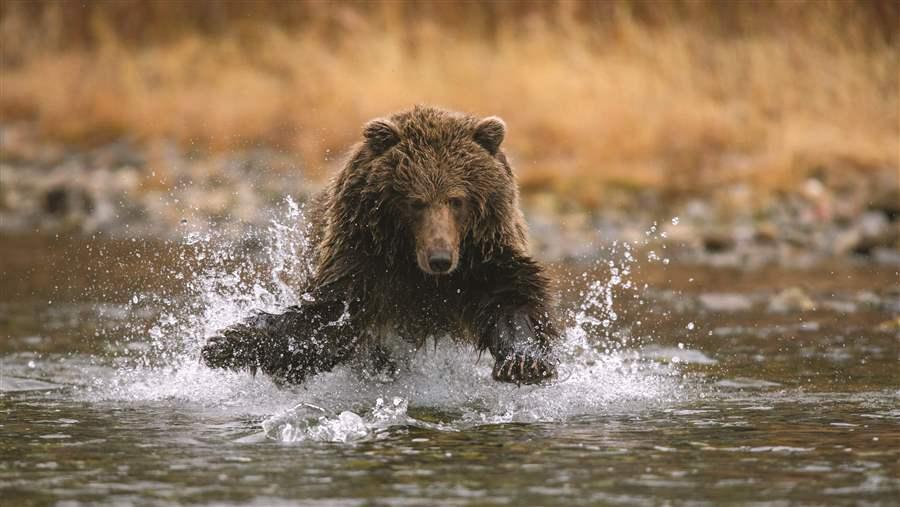 Paul Nicklen/National Geographic Creative
Paul Nicklen/National Geographic CreativeThe boreal forest provides vital habitat for grizzly bears, which have lost much of their historical range elsewhere in North America.
Global leaders in forest conservation
Canada has made remarkable conservation progress in its boreal region over the past 15 years, and more is promised. The nation’s two largest provinces, Ontario and Quebec, have committed to strictly protecting 50 percent of their boreal forest regions as parks or nature refuges, while promoting smart development in the other half. Industry, environmentalists, Indigenous peoples, and governments are developing new models of cooperation as other jurisdictions make land use decisions for the future. Consider these success stories:
- The Far North Act. Ontario passed legislation in 2010 that set targets for strict protection and for sustainable development of 110 million acres of boreal forest. It was the first provincial-scale law to incorporate the 50-50 approach to forest conservation in Canada. The bill provides for community-based land use planning byOntario’s Indigenous First Nations, working with the province.
- Plan Nord. Quebec committed in 2011 to protect at least 50 percent of its 295 million-acre boreal region over the next 25 years. This comprehensive plan for conservation and sustainable development in the province’s north led directly to creation of the 6.5 million-acre Tursujuq National Park in July 2013. The park straddles an ecological transition zone that includes boreal and arctic regions and is about three times the size of Yellowstone National Park. In October 2014, Quebec renewed its commitment to the conservation targets in the Plan Nord.
- Indigenous land use planning. More than 600 Indigenous communities make their homes in the boreal forest, and many are taking innovative approaches to conservation planning on their traditional lands. In the Northwest Territories, the Deh Cho First Nations worked with Canada’s federal government to expand Nahanni National Park Reserve fourfold, and it now encompasses the entire 7.8 million-acre watershed. The Lutsel K’e Dene, also in the Northwest Territories, have initialed a framework agreement with the federal government to jointly manage the proposed Thaidene Nene National Park Reserve. The draft plan recognizes Dene authority and would ensure that traditional cultural and environmental practices inform operations of the 7.4 million-acre park. In Labrador, the Innu First Nations have used traditional knowledge as well as modern science and tools for land use planning to establish a 3.2 million-acre federal and provincial park in the Mealy Mountains. There are many more examples as Indigenous land use planning, pursuant to treaties and land settlements, gathers momentum across the boreal.
- Northwest Territories. The territorial government in 2014 used new powers over its natural resources to adopt legally binding interim protections for 18.9 million acres of boreal parks and refuges that had been originally designated by the federal government in Ottawa. The protected areas include the proposed Edéhzhíe National Wildlife Area (Horn Plateau), Ts’ude niline Tu’eyeta National Wildlife Area (Ramparts River), and Thaidene Nene National Park Reserve. Each has ecological importance and cultural significance to the Indigenous peoples of the Northwest Territories.
- Manitoba. The provincial government is supporting World Heritage site designation for Pimachiowin Aki, which encompasses 10.6 million acres of traditional Indigenous territory and provincial parks within Canada’s boreal shield on the east side of Lake Winnipeg. Manitoba launched several initiatives in 2014 that will help protect boreal forest, including a nation-leading woodland caribou conservation plan and a peatlands stewardship strategy that would ban peat harvesting in provincial parks and wildlife management areas. The new Chitek Lake Provincial Park will protect more than 250,000 acres of boreal forest, an area larger than Badlands National Park in South Dakota.
- Saskatchewan and Alberta. Although comprehensive plans have yet to be announced, both provinces have taken positive steps to protect some of their remaining boreal forests. In 2013, Saskatchewan designated the Pink Lake Ecological Reserve in the province’s northern boreal region as a protected area. The 820,000-acre reserve is larger than Yosemite National Park. The designation prohibits new industrial developments in the area. Alberta, meanwhile, has committed to protecting about 3.9 million acres of boreal forest in its Lower Athabasca Regional Plan.
- Canadian Boreal Forest Agreement. In 2010, Canada’s forest industry and several leading environmental groups signed the largest conservation agreement in history. Under the pact, timber firms agreed to temporarily suspend operations in roughly 71 million acres of forest, representing a significant portion of habitat for Canada’s threatened woodland caribou population. The agreement requires improved logging and sustainability practices on at least 108 million acres.
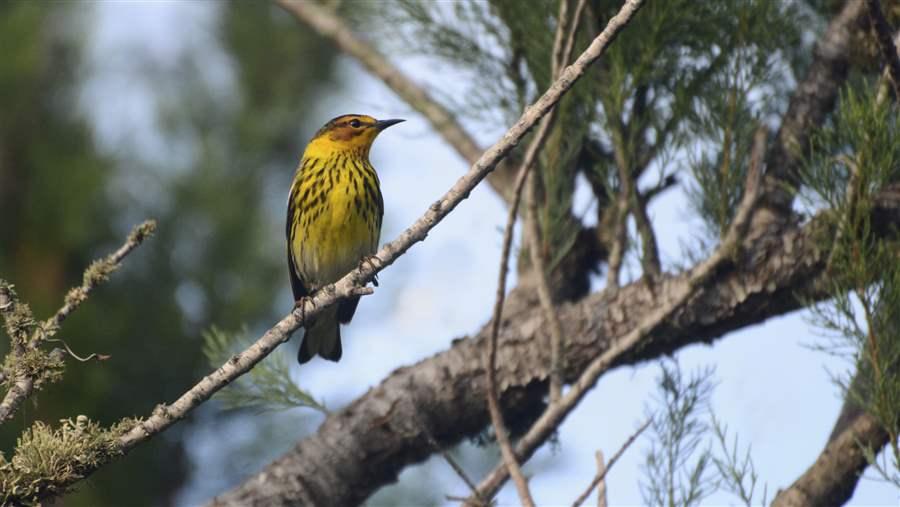 Don Keith/Getty Images
Don Keith/Getty ImagesMore than 80 percent of the world’s threatened Cape May warblers breed in the boreal forest.
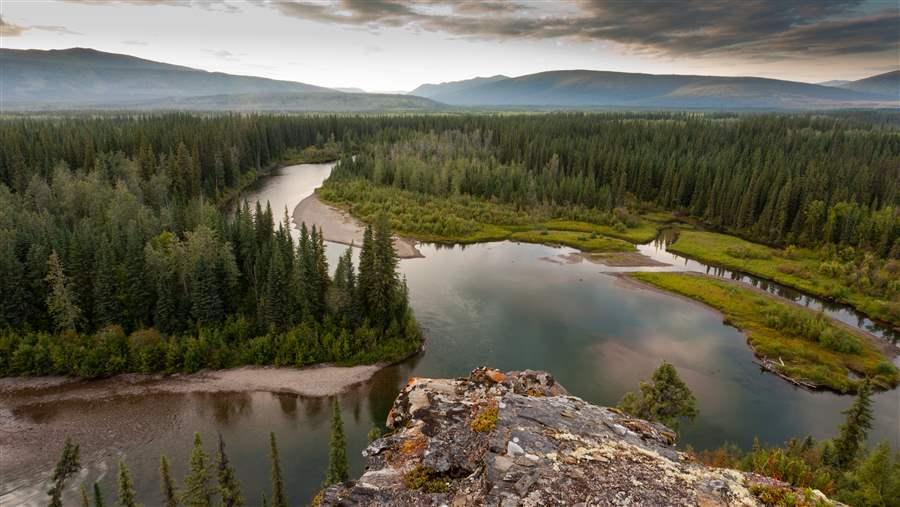 Shutterstock
ShutterstockBoreal wilderness in the Yukon’s McQuesten River valley.
In all, more than 350 million acres of boreal forest in Canada are either strictly protected or under interim protection, or have been committed for protections. Furthermore, governments have pledged to sustainably develop more than 350 million additional acres using world-leading, ecosystem-based resource management practices and state-of-the-art stewardship practices. Much work remains to be done. Protecting the boreal forest will be a years-long process requiring patience, vision, and leadership among all stakeholders. But the goal is achievable and within reach.
